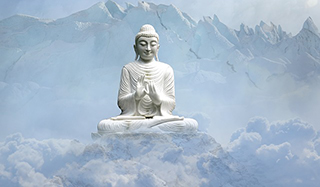
Writing about a dharma journey without exploring meditation would be possible but probably not for me. What is meditation? B.K.S. Iyengar (2002) teaches us “dhyana is not self-induced trance.” Meditation is a contemplative practice. Meditation takes on many forms. the Vijñāna Bhairava Tantra (Radiance Sutras) suggests over 100 ways to meditate (Roche & Rea, 2014).
The first time I ever thought about meditating was in high school and it was suggested to me to meditate on a blue dot. I did not have a clue what that meant but I gave it a try. I was not very successful but have sense learned more about the blue dot and discovered that meditation is very much about forgiving yourself and starting over and over and over again. Even the Dalai Lama admits to problems with his practice. I have certainly heard that the reason meditation is called a practice is because the meditator is always just practicing only realizing understanding for brief moments.
The first formal and perhaps only formal training I had in meditation was in college. I took training from the Students International Meditation Society (SIMS). I remember gathering up flowers and some fruit for the initiation. I was lucky to have a friend who worked in the university’s greenhouse so I had some of the coolest flowers. SIMS taught transcendental mediation (TM) as brought to the world by the Maharishi Mahesh Yogi of Beatles fame. TM is mantra meditation which is simply repeating a mantra (a sound or word) over and over. The original teaching suggested 20 minutes of meditation twice a day. The mantra each student was given was supposed to be just for them. I was skeptical of just how personal since how could the instructor know me well enough to determine which mantra I should have. I have seen found out that the mantras came from a chart if the Internet is be believed. SIMS is no longer in operation but you can still receive training in TM from several sources one of which is the David Lynch Foundation, yes the David Lynch of Twin Peaks fame.
I expect to visit the topic of meditation many times in the future as much to clarify my own thinking as to inform my readers. If you are interested in learning to mediate I suggest getting involved with a meditation group (sangha). Many such groups exist all over the country and frequently provide basic meditation instruction for free. If you live in the hinter lands such groups even exist online. The groups will accept donations (dana) but rarely is that required. Definitely do not pay anyone a large some of money to learn to meditate. Plenty of people in this world are willing to take you money but there are plenty of reputable people who provide instruction in meditation for free.
I will discuss teachers more in later posts. Truly gifted teachers can see deeply into their students and can help them on their path. Don’t believe anyone who says meditation is a quick and easy path. The student can gain benefits very quickly but this is an endurance event not a sprint. Don’t get discouraged just start over.
My personal preferences are for Buddhist forms of meditation but what is important is find the style that fits you best. Finding a best fit will probably involved trying different styles I know of few teachers with insight to be able to direct you on the path you need to follow. Most teachers can help you on the path that they have chosen. While frustrating at times sometimes the least instruction is the best.
I have read many books on meditation so part of what I will be doing is reviewing some of these books. Some of the books are instructional in nature while others are more of an analysis of meditation. I am constantly looking for direction on this path
Iyengar, B. K. S. (2002). Light on the Yoga Sutras of Patanjali (New edition edition). London: Thorsons.
Roche, L., & Rea, S. (2014). The Radiance Sutras: 112 Gateways to the Yoga of Wonder and Delight (1st edition). Boulder, Colorado: Sounds True.
The image came from the Creative Commons.
Comments are closed.